Principles of Episodic Care for Type-2 Diabetes
VerifiedAdded on 2023/01/23
|11
|3334
|85
AI Summary
This assignment analyzes the case study of Jenny and sheds light on different aspects of type-2 diabetes, helping nurses develop knowledge and take preventive measures.
Contribute Materials
Your contribution can guide someone’s learning journey. Share your
documents today.
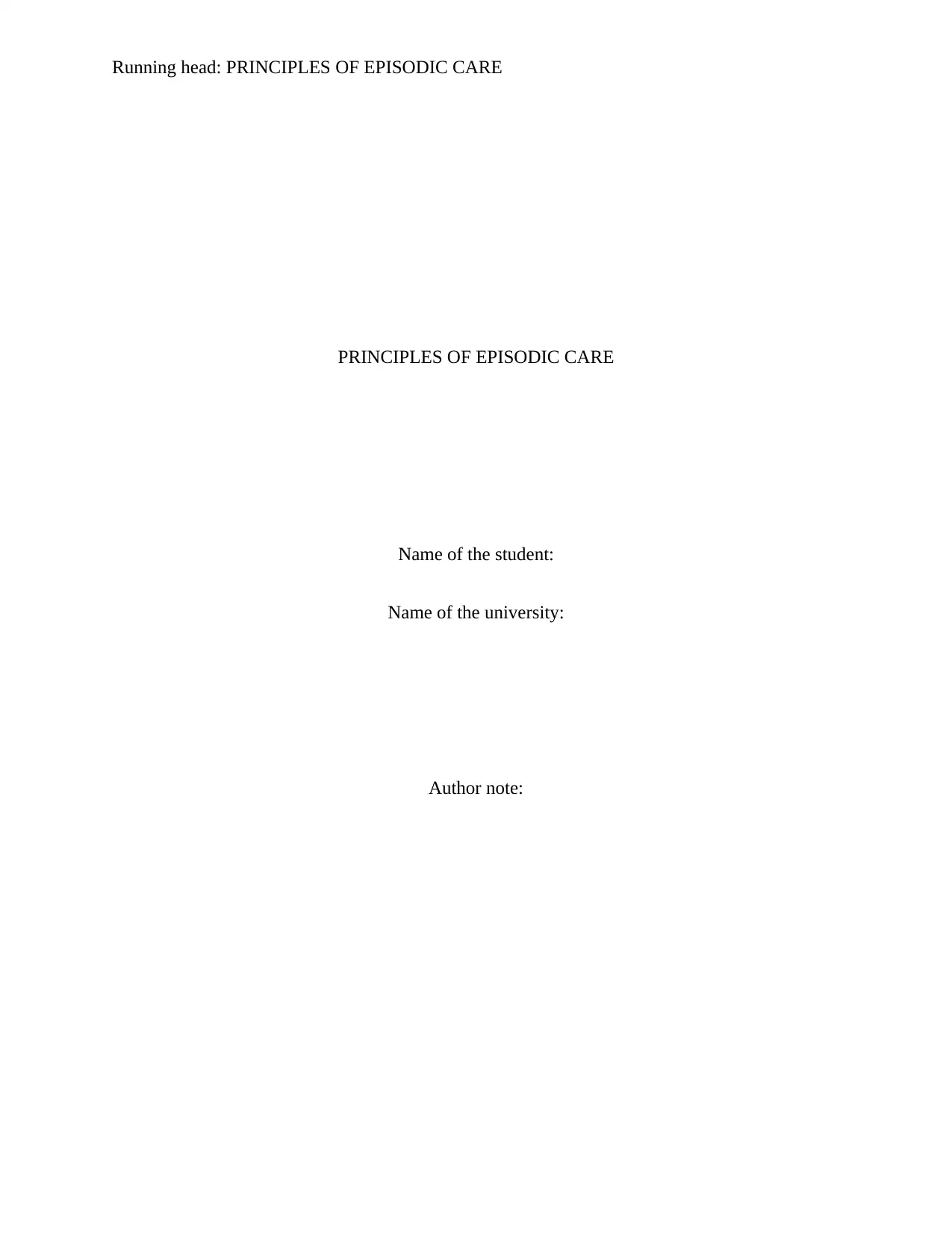
Running head: PRINCIPLES OF EPISODIC CARE
PRINCIPLES OF EPISODIC CARE
Name of the student:
Name of the university:
Author note:
PRINCIPLES OF EPISODIC CARE
Name of the student:
Name of the university:
Author note:
Secure Best Marks with AI Grader
Need help grading? Try our AI Grader for instant feedback on your assignments.
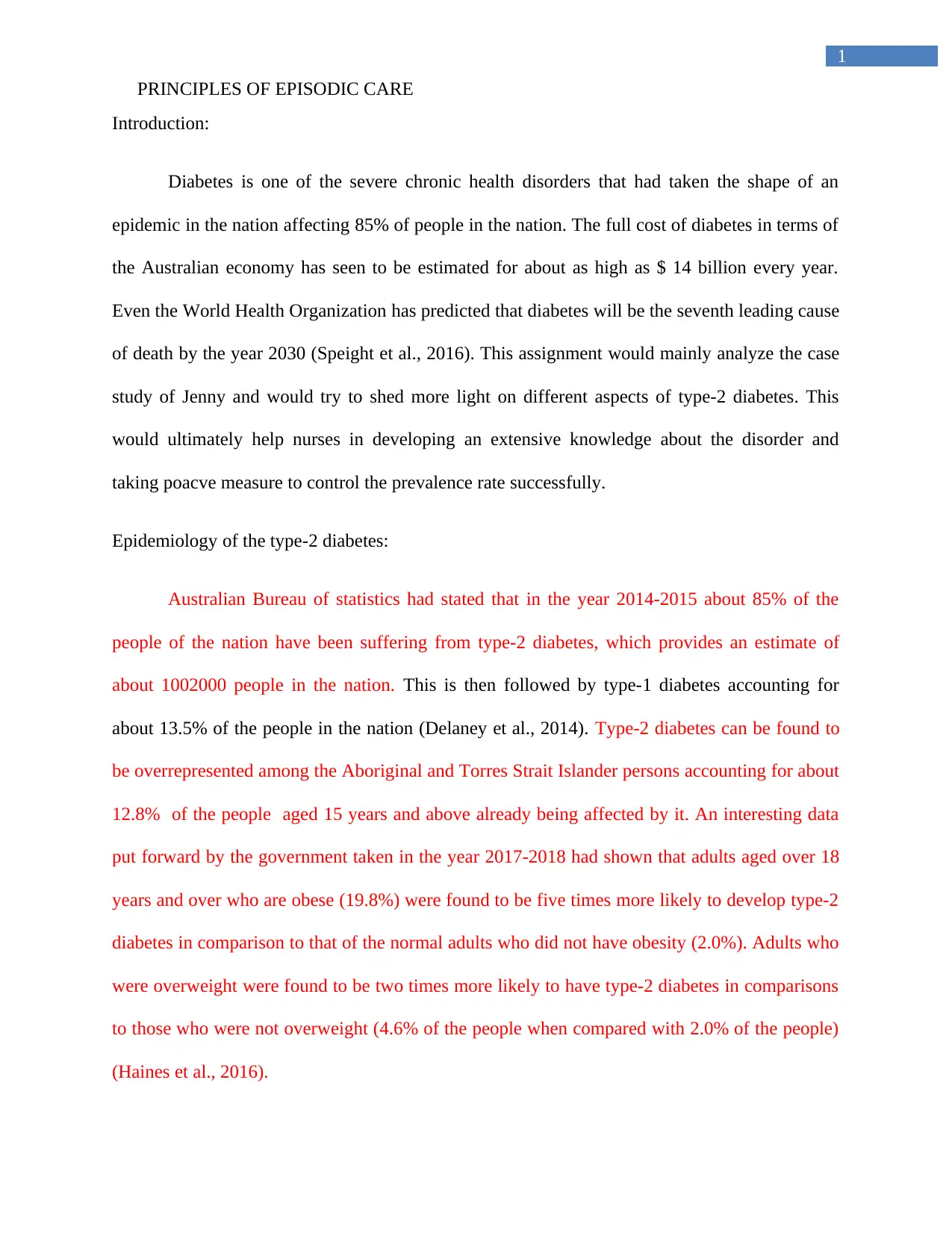
1
PRINCIPLES OF EPISODIC CARE
Introduction:
Diabetes is one of the severe chronic health disorders that had taken the shape of an
epidemic in the nation affecting 85% of people in the nation. The full cost of diabetes in terms of
the Australian economy has seen to be estimated for about as high as $ 14 billion every year.
Even the World Health Organization has predicted that diabetes will be the seventh leading cause
of death by the year 2030 (Speight et al., 2016). This assignment would mainly analyze the case
study of Jenny and would try to shed more light on different aspects of type-2 diabetes. This
would ultimately help nurses in developing an extensive knowledge about the disorder and
taking poacve measure to control the prevalence rate successfully.
Epidemiology of the type-2 diabetes:
Australian Bureau of statistics had stated that in the year 2014-2015 about 85% of the
people of the nation have been suffering from type-2 diabetes, which provides an estimate of
about 1002000 people in the nation. This is then followed by type-1 diabetes accounting for
about 13.5% of the people in the nation (Delaney et al., 2014). Type-2 diabetes can be found to
be overrepresented among the Aboriginal and Torres Strait Islander persons accounting for about
12.8% of the people aged 15 years and above already being affected by it. An interesting data
put forward by the government taken in the year 2017-2018 had shown that adults aged over 18
years and over who are obese (19.8%) were found to be five times more likely to develop type-2
diabetes in comparison to that of the normal adults who did not have obesity (2.0%). Adults who
were overweight were found to be two times more likely to have type-2 diabetes in comparisons
to those who were not overweight (4.6% of the people when compared with 2.0% of the people)
(Haines et al., 2016).
PRINCIPLES OF EPISODIC CARE
Introduction:
Diabetes is one of the severe chronic health disorders that had taken the shape of an
epidemic in the nation affecting 85% of people in the nation. The full cost of diabetes in terms of
the Australian economy has seen to be estimated for about as high as $ 14 billion every year.
Even the World Health Organization has predicted that diabetes will be the seventh leading cause
of death by the year 2030 (Speight et al., 2016). This assignment would mainly analyze the case
study of Jenny and would try to shed more light on different aspects of type-2 diabetes. This
would ultimately help nurses in developing an extensive knowledge about the disorder and
taking poacve measure to control the prevalence rate successfully.
Epidemiology of the type-2 diabetes:
Australian Bureau of statistics had stated that in the year 2014-2015 about 85% of the
people of the nation have been suffering from type-2 diabetes, which provides an estimate of
about 1002000 people in the nation. This is then followed by type-1 diabetes accounting for
about 13.5% of the people in the nation (Delaney et al., 2014). Type-2 diabetes can be found to
be overrepresented among the Aboriginal and Torres Strait Islander persons accounting for about
12.8% of the people aged 15 years and above already being affected by it. An interesting data
put forward by the government taken in the year 2017-2018 had shown that adults aged over 18
years and over who are obese (19.8%) were found to be five times more likely to develop type-2
diabetes in comparison to that of the normal adults who did not have obesity (2.0%). Adults who
were overweight were found to be two times more likely to have type-2 diabetes in comparisons
to those who were not overweight (4.6% of the people when compared with 2.0% of the people)
(Haines et al., 2016).
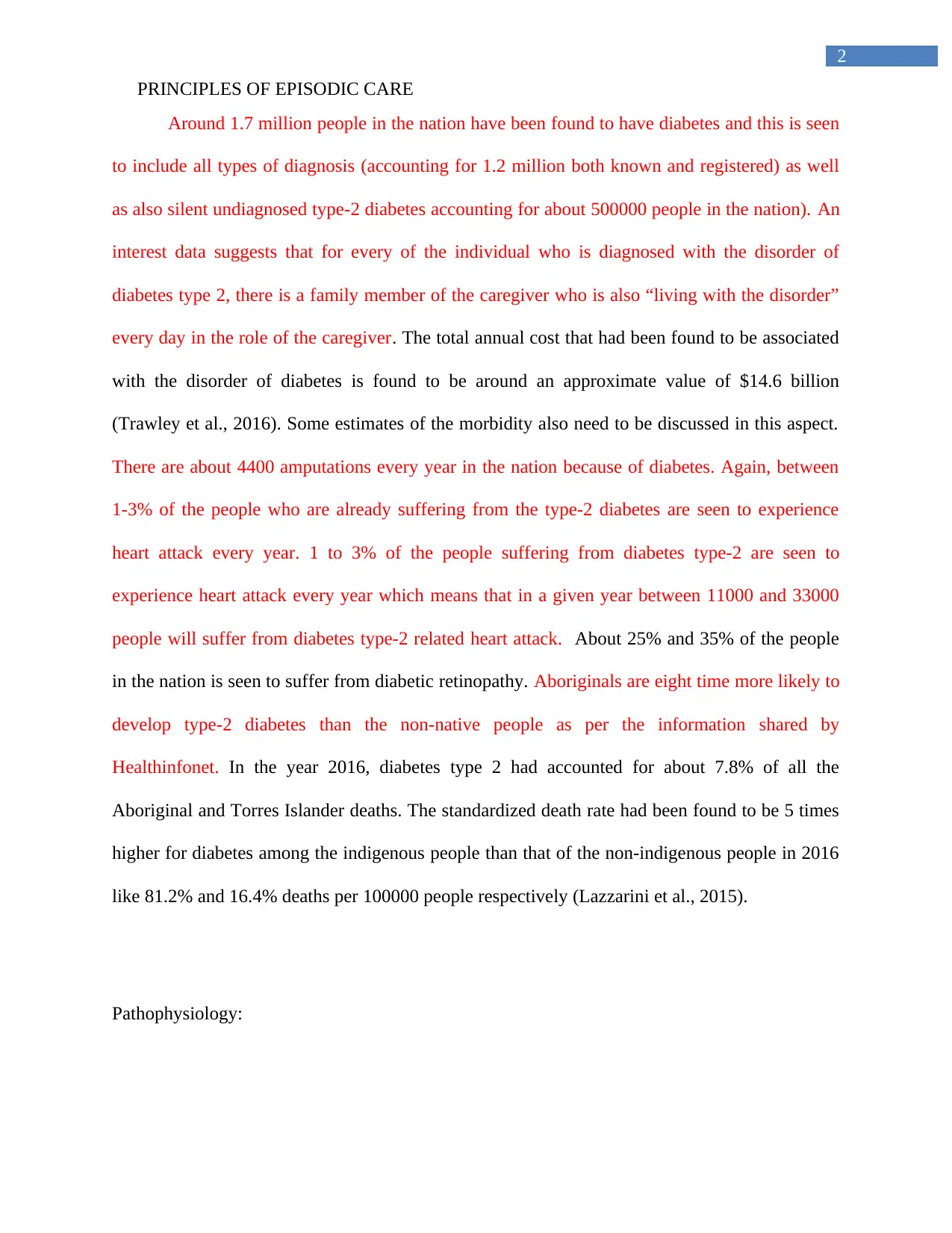
2
PRINCIPLES OF EPISODIC CARE
Around 1.7 million people in the nation have been found to have diabetes and this is seen
to include all types of diagnosis (accounting for 1.2 million both known and registered) as well
as also silent undiagnosed type-2 diabetes accounting for about 500000 people in the nation). An
interest data suggests that for every of the individual who is diagnosed with the disorder of
diabetes type 2, there is a family member of the caregiver who is also “living with the disorder”
every day in the role of the caregiver. The total annual cost that had been found to be associated
with the disorder of diabetes is found to be around an approximate value of $14.6 billion
(Trawley et al., 2016). Some estimates of the morbidity also need to be discussed in this aspect.
There are about 4400 amputations every year in the nation because of diabetes. Again, between
1-3% of the people who are already suffering from the type-2 diabetes are seen to experience
heart attack every year. 1 to 3% of the people suffering from diabetes type-2 are seen to
experience heart attack every year which means that in a given year between 11000 and 33000
people will suffer from diabetes type-2 related heart attack. About 25% and 35% of the people
in the nation is seen to suffer from diabetic retinopathy. Aboriginals are eight time more likely to
develop type-2 diabetes than the non-native people as per the information shared by
Healthinfonet. In the year 2016, diabetes type 2 had accounted for about 7.8% of all the
Aboriginal and Torres Islander deaths. The standardized death rate had been found to be 5 times
higher for diabetes among the indigenous people than that of the non-indigenous people in 2016
like 81.2% and 16.4% deaths per 100000 people respectively (Lazzarini et al., 2015).
Pathophysiology:
PRINCIPLES OF EPISODIC CARE
Around 1.7 million people in the nation have been found to have diabetes and this is seen
to include all types of diagnosis (accounting for 1.2 million both known and registered) as well
as also silent undiagnosed type-2 diabetes accounting for about 500000 people in the nation). An
interest data suggests that for every of the individual who is diagnosed with the disorder of
diabetes type 2, there is a family member of the caregiver who is also “living with the disorder”
every day in the role of the caregiver. The total annual cost that had been found to be associated
with the disorder of diabetes is found to be around an approximate value of $14.6 billion
(Trawley et al., 2016). Some estimates of the morbidity also need to be discussed in this aspect.
There are about 4400 amputations every year in the nation because of diabetes. Again, between
1-3% of the people who are already suffering from the type-2 diabetes are seen to experience
heart attack every year. 1 to 3% of the people suffering from diabetes type-2 are seen to
experience heart attack every year which means that in a given year between 11000 and 33000
people will suffer from diabetes type-2 related heart attack. About 25% and 35% of the people
in the nation is seen to suffer from diabetic retinopathy. Aboriginals are eight time more likely to
develop type-2 diabetes than the non-native people as per the information shared by
Healthinfonet. In the year 2016, diabetes type 2 had accounted for about 7.8% of all the
Aboriginal and Torres Islander deaths. The standardized death rate had been found to be 5 times
higher for diabetes among the indigenous people than that of the non-indigenous people in 2016
like 81.2% and 16.4% deaths per 100000 people respectively (Lazzarini et al., 2015).
Pathophysiology:
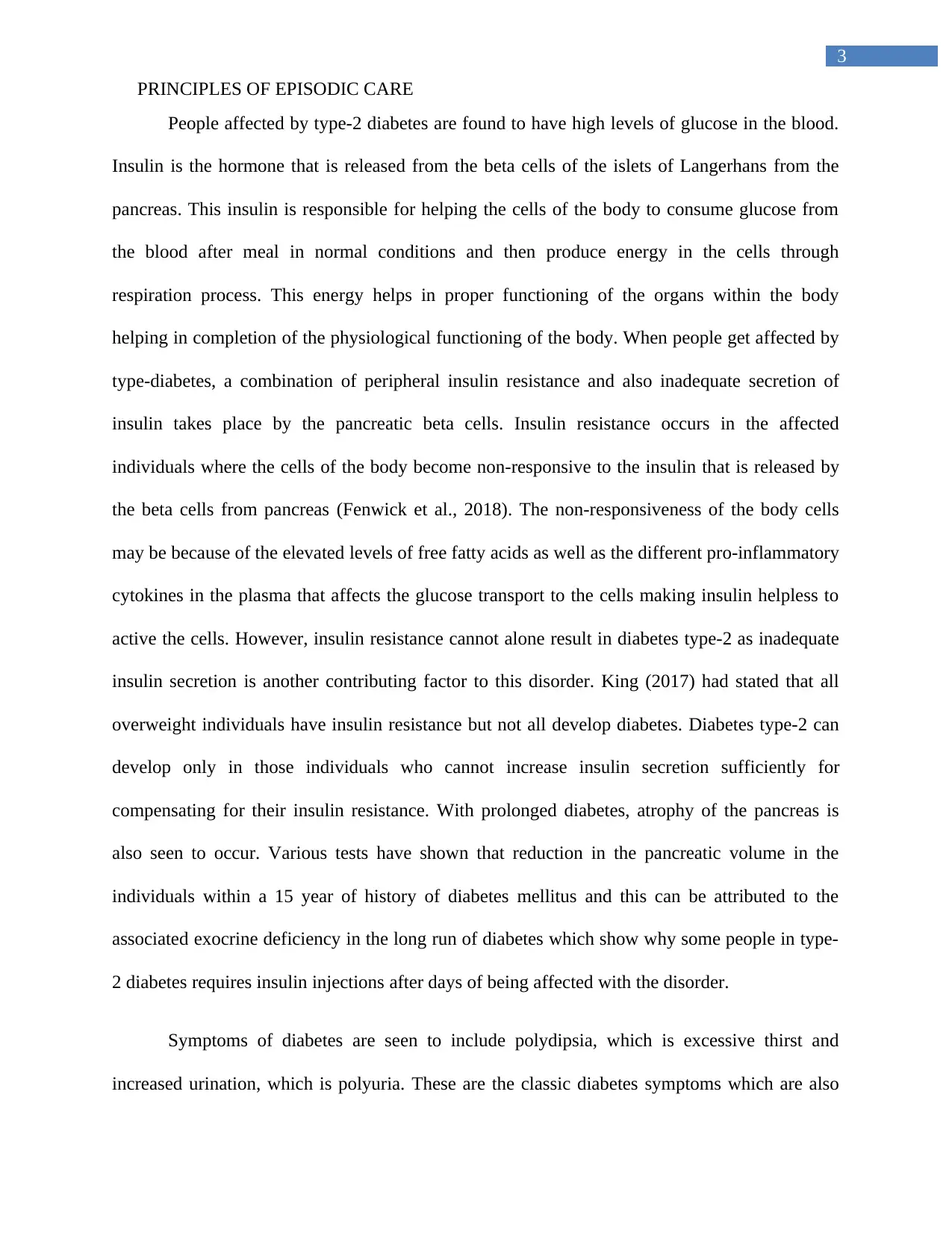
3
PRINCIPLES OF EPISODIC CARE
People affected by type-2 diabetes are found to have high levels of glucose in the blood.
Insulin is the hormone that is released from the beta cells of the islets of Langerhans from the
pancreas. This insulin is responsible for helping the cells of the body to consume glucose from
the blood after meal in normal conditions and then produce energy in the cells through
respiration process. This energy helps in proper functioning of the organs within the body
helping in completion of the physiological functioning of the body. When people get affected by
type-diabetes, a combination of peripheral insulin resistance and also inadequate secretion of
insulin takes place by the pancreatic beta cells. Insulin resistance occurs in the affected
individuals where the cells of the body become non-responsive to the insulin that is released by
the beta cells from pancreas (Fenwick et al., 2018). The non-responsiveness of the body cells
may be because of the elevated levels of free fatty acids as well as the different pro-inflammatory
cytokines in the plasma that affects the glucose transport to the cells making insulin helpless to
active the cells. However, insulin resistance cannot alone result in diabetes type-2 as inadequate
insulin secretion is another contributing factor to this disorder. King (2017) had stated that all
overweight individuals have insulin resistance but not all develop diabetes. Diabetes type-2 can
develop only in those individuals who cannot increase insulin secretion sufficiently for
compensating for their insulin resistance. With prolonged diabetes, atrophy of the pancreas is
also seen to occur. Various tests have shown that reduction in the pancreatic volume in the
individuals within a 15 year of history of diabetes mellitus and this can be attributed to the
associated exocrine deficiency in the long run of diabetes which show why some people in type-
2 diabetes requires insulin injections after days of being affected with the disorder.
Symptoms of diabetes are seen to include polydipsia, which is excessive thirst and
increased urination, which is polyuria. These are the classic diabetes symptoms which are also
PRINCIPLES OF EPISODIC CARE
People affected by type-2 diabetes are found to have high levels of glucose in the blood.
Insulin is the hormone that is released from the beta cells of the islets of Langerhans from the
pancreas. This insulin is responsible for helping the cells of the body to consume glucose from
the blood after meal in normal conditions and then produce energy in the cells through
respiration process. This energy helps in proper functioning of the organs within the body
helping in completion of the physiological functioning of the body. When people get affected by
type-diabetes, a combination of peripheral insulin resistance and also inadequate secretion of
insulin takes place by the pancreatic beta cells. Insulin resistance occurs in the affected
individuals where the cells of the body become non-responsive to the insulin that is released by
the beta cells from pancreas (Fenwick et al., 2018). The non-responsiveness of the body cells
may be because of the elevated levels of free fatty acids as well as the different pro-inflammatory
cytokines in the plasma that affects the glucose transport to the cells making insulin helpless to
active the cells. However, insulin resistance cannot alone result in diabetes type-2 as inadequate
insulin secretion is another contributing factor to this disorder. King (2017) had stated that all
overweight individuals have insulin resistance but not all develop diabetes. Diabetes type-2 can
develop only in those individuals who cannot increase insulin secretion sufficiently for
compensating for their insulin resistance. With prolonged diabetes, atrophy of the pancreas is
also seen to occur. Various tests have shown that reduction in the pancreatic volume in the
individuals within a 15 year of history of diabetes mellitus and this can be attributed to the
associated exocrine deficiency in the long run of diabetes which show why some people in type-
2 diabetes requires insulin injections after days of being affected with the disorder.
Symptoms of diabetes are seen to include polydipsia, which is excessive thirst and
increased urination, which is polyuria. These are the classic diabetes symptoms which are also
Secure Best Marks with AI Grader
Need help grading? Try our AI Grader for instant feedback on your assignments.
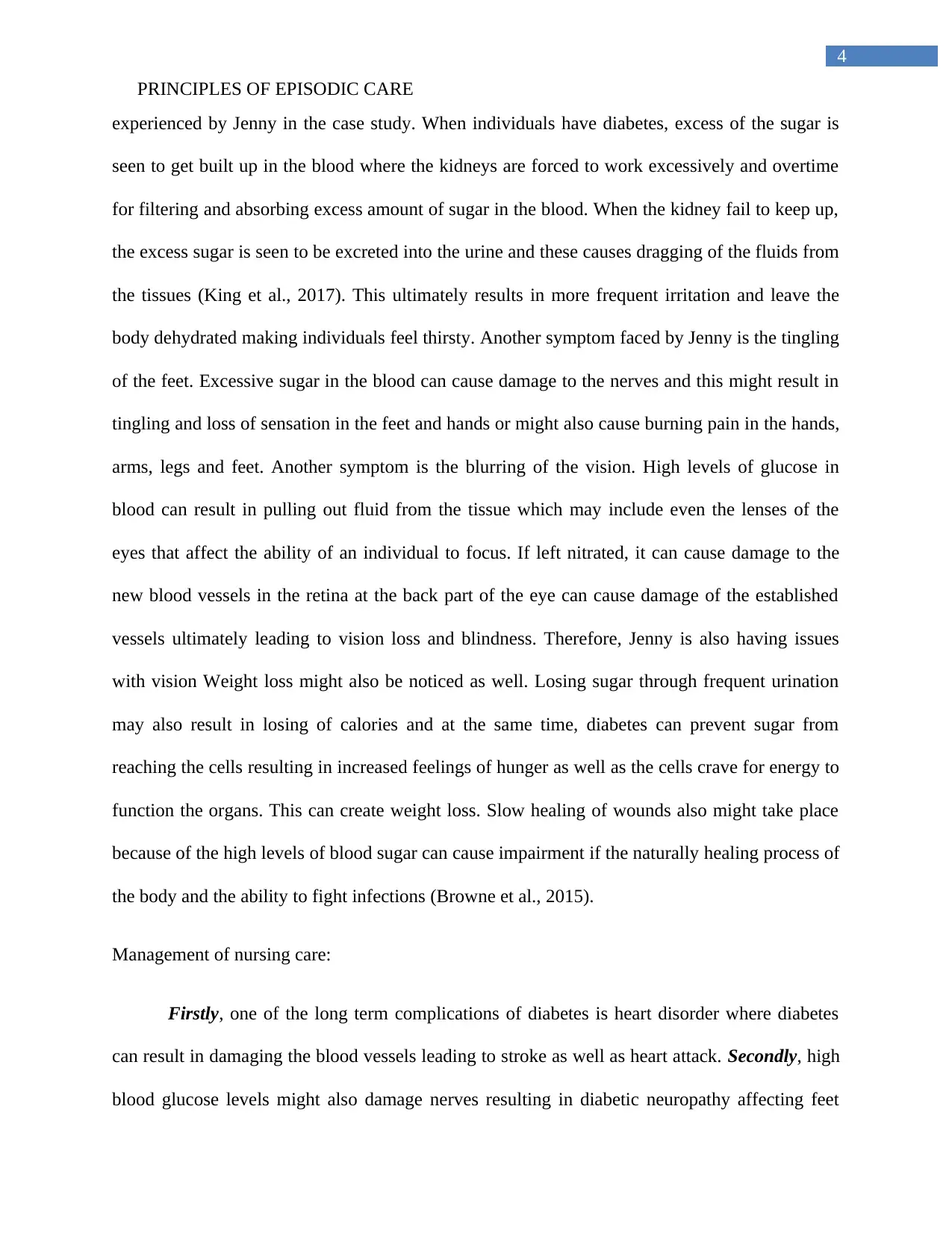
4
PRINCIPLES OF EPISODIC CARE
experienced by Jenny in the case study. When individuals have diabetes, excess of the sugar is
seen to get built up in the blood where the kidneys are forced to work excessively and overtime
for filtering and absorbing excess amount of sugar in the blood. When the kidney fail to keep up,
the excess sugar is seen to be excreted into the urine and these causes dragging of the fluids from
the tissues (King et al., 2017). This ultimately results in more frequent irritation and leave the
body dehydrated making individuals feel thirsty. Another symptom faced by Jenny is the tingling
of the feet. Excessive sugar in the blood can cause damage to the nerves and this might result in
tingling and loss of sensation in the feet and hands or might also cause burning pain in the hands,
arms, legs and feet. Another symptom is the blurring of the vision. High levels of glucose in
blood can result in pulling out fluid from the tissue which may include even the lenses of the
eyes that affect the ability of an individual to focus. If left nitrated, it can cause damage to the
new blood vessels in the retina at the back part of the eye can cause damage of the established
vessels ultimately leading to vision loss and blindness. Therefore, Jenny is also having issues
with vision Weight loss might also be noticed as well. Losing sugar through frequent urination
may also result in losing of calories and at the same time, diabetes can prevent sugar from
reaching the cells resulting in increased feelings of hunger as well as the cells crave for energy to
function the organs. This can create weight loss. Slow healing of wounds also might take place
because of the high levels of blood sugar can cause impairment if the naturally healing process of
the body and the ability to fight infections (Browne et al., 2015).
Management of nursing care:
Firstly, one of the long term complications of diabetes is heart disorder where diabetes
can result in damaging the blood vessels leading to stroke as well as heart attack. Secondly, high
blood glucose levels might also damage nerves resulting in diabetic neuropathy affecting feet
PRINCIPLES OF EPISODIC CARE
experienced by Jenny in the case study. When individuals have diabetes, excess of the sugar is
seen to get built up in the blood where the kidneys are forced to work excessively and overtime
for filtering and absorbing excess amount of sugar in the blood. When the kidney fail to keep up,
the excess sugar is seen to be excreted into the urine and these causes dragging of the fluids from
the tissues (King et al., 2017). This ultimately results in more frequent irritation and leave the
body dehydrated making individuals feel thirsty. Another symptom faced by Jenny is the tingling
of the feet. Excessive sugar in the blood can cause damage to the nerves and this might result in
tingling and loss of sensation in the feet and hands or might also cause burning pain in the hands,
arms, legs and feet. Another symptom is the blurring of the vision. High levels of glucose in
blood can result in pulling out fluid from the tissue which may include even the lenses of the
eyes that affect the ability of an individual to focus. If left nitrated, it can cause damage to the
new blood vessels in the retina at the back part of the eye can cause damage of the established
vessels ultimately leading to vision loss and blindness. Therefore, Jenny is also having issues
with vision Weight loss might also be noticed as well. Losing sugar through frequent urination
may also result in losing of calories and at the same time, diabetes can prevent sugar from
reaching the cells resulting in increased feelings of hunger as well as the cells crave for energy to
function the organs. This can create weight loss. Slow healing of wounds also might take place
because of the high levels of blood sugar can cause impairment if the naturally healing process of
the body and the ability to fight infections (Browne et al., 2015).
Management of nursing care:
Firstly, one of the long term complications of diabetes is heart disorder where diabetes
can result in damaging the blood vessels leading to stroke as well as heart attack. Secondly, high
blood glucose levels might also damage nerves resulting in diabetic neuropathy affecting feet
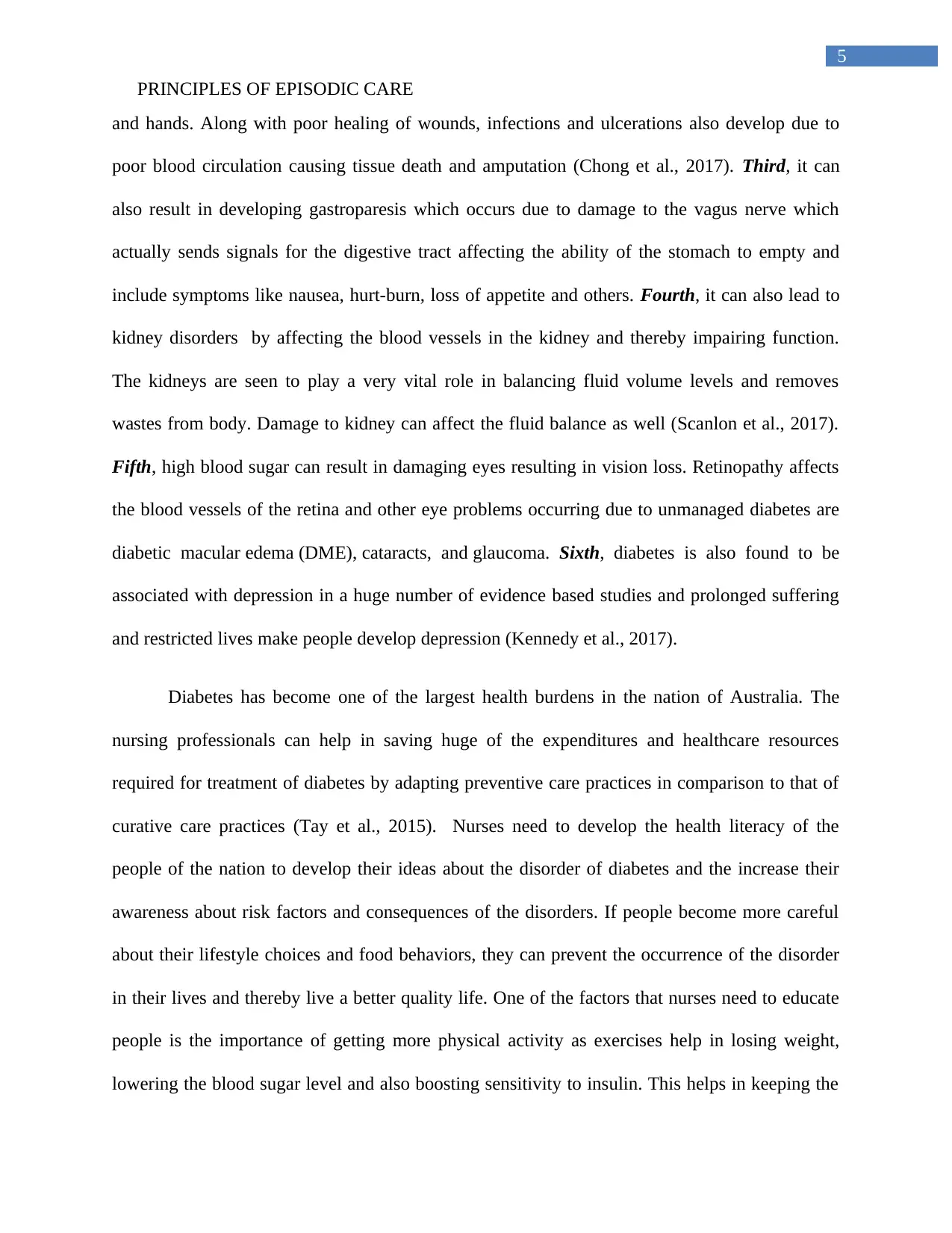
5
PRINCIPLES OF EPISODIC CARE
and hands. Along with poor healing of wounds, infections and ulcerations also develop due to
poor blood circulation causing tissue death and amputation (Chong et al., 2017). Third, it can
also result in developing gastroparesis which occurs due to damage to the vagus nerve which
actually sends signals for the digestive tract affecting the ability of the stomach to empty and
include symptoms like nausea, hurt-burn, loss of appetite and others. Fourth, it can also lead to
kidney disorders by affecting the blood vessels in the kidney and thereby impairing function.
The kidneys are seen to play a very vital role in balancing fluid volume levels and removes
wastes from body. Damage to kidney can affect the fluid balance as well (Scanlon et al., 2017).
Fifth, high blood sugar can result in damaging eyes resulting in vision loss. Retinopathy affects
the blood vessels of the retina and other eye problems occurring due to unmanaged diabetes are
diabetic macular edema (DME), cataracts, and glaucoma. Sixth, diabetes is also found to be
associated with depression in a huge number of evidence based studies and prolonged suffering
and restricted lives make people develop depression (Kennedy et al., 2017).
Diabetes has become one of the largest health burdens in the nation of Australia. The
nursing professionals can help in saving huge of the expenditures and healthcare resources
required for treatment of diabetes by adapting preventive care practices in comparison to that of
curative care practices (Tay et al., 2015). Nurses need to develop the health literacy of the
people of the nation to develop their ideas about the disorder of diabetes and the increase their
awareness about risk factors and consequences of the disorders. If people become more careful
about their lifestyle choices and food behaviors, they can prevent the occurrence of the disorder
in their lives and thereby live a better quality life. One of the factors that nurses need to educate
people is the importance of getting more physical activity as exercises help in losing weight,
lowering the blood sugar level and also boosting sensitivity to insulin. This helps in keeping the
PRINCIPLES OF EPISODIC CARE
and hands. Along with poor healing of wounds, infections and ulcerations also develop due to
poor blood circulation causing tissue death and amputation (Chong et al., 2017). Third, it can
also result in developing gastroparesis which occurs due to damage to the vagus nerve which
actually sends signals for the digestive tract affecting the ability of the stomach to empty and
include symptoms like nausea, hurt-burn, loss of appetite and others. Fourth, it can also lead to
kidney disorders by affecting the blood vessels in the kidney and thereby impairing function.
The kidneys are seen to play a very vital role in balancing fluid volume levels and removes
wastes from body. Damage to kidney can affect the fluid balance as well (Scanlon et al., 2017).
Fifth, high blood sugar can result in damaging eyes resulting in vision loss. Retinopathy affects
the blood vessels of the retina and other eye problems occurring due to unmanaged diabetes are
diabetic macular edema (DME), cataracts, and glaucoma. Sixth, diabetes is also found to be
associated with depression in a huge number of evidence based studies and prolonged suffering
and restricted lives make people develop depression (Kennedy et al., 2017).
Diabetes has become one of the largest health burdens in the nation of Australia. The
nursing professionals can help in saving huge of the expenditures and healthcare resources
required for treatment of diabetes by adapting preventive care practices in comparison to that of
curative care practices (Tay et al., 2015). Nurses need to develop the health literacy of the
people of the nation to develop their ideas about the disorder of diabetes and the increase their
awareness about risk factors and consequences of the disorders. If people become more careful
about their lifestyle choices and food behaviors, they can prevent the occurrence of the disorder
in their lives and thereby live a better quality life. One of the factors that nurses need to educate
people is the importance of getting more physical activity as exercises help in losing weight,
lowering the blood sugar level and also boosting sensitivity to insulin. This helps in keeping the
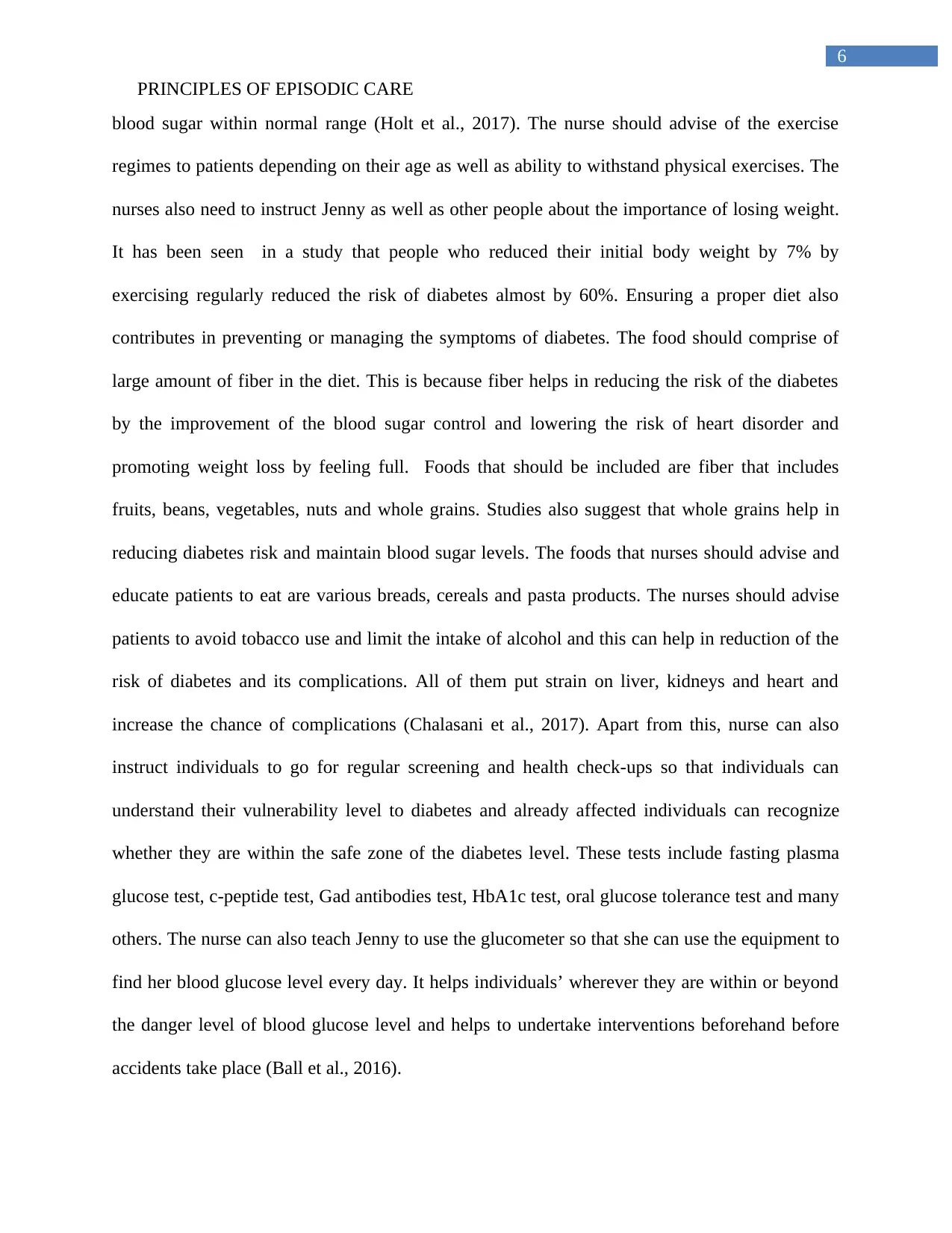
6
PRINCIPLES OF EPISODIC CARE
blood sugar within normal range (Holt et al., 2017). The nurse should advise of the exercise
regimes to patients depending on their age as well as ability to withstand physical exercises. The
nurses also need to instruct Jenny as well as other people about the importance of losing weight.
It has been seen in a study that people who reduced their initial body weight by 7% by
exercising regularly reduced the risk of diabetes almost by 60%. Ensuring a proper diet also
contributes in preventing or managing the symptoms of diabetes. The food should comprise of
large amount of fiber in the diet. This is because fiber helps in reducing the risk of the diabetes
by the improvement of the blood sugar control and lowering the risk of heart disorder and
promoting weight loss by feeling full. Foods that should be included are fiber that includes
fruits, beans, vegetables, nuts and whole grains. Studies also suggest that whole grains help in
reducing diabetes risk and maintain blood sugar levels. The foods that nurses should advise and
educate patients to eat are various breads, cereals and pasta products. The nurses should advise
patients to avoid tobacco use and limit the intake of alcohol and this can help in reduction of the
risk of diabetes and its complications. All of them put strain on liver, kidneys and heart and
increase the chance of complications (Chalasani et al., 2017). Apart from this, nurse can also
instruct individuals to go for regular screening and health check-ups so that individuals can
understand their vulnerability level to diabetes and already affected individuals can recognize
whether they are within the safe zone of the diabetes level. These tests include fasting plasma
glucose test, c-peptide test, Gad antibodies test, HbA1c test, oral glucose tolerance test and many
others. The nurse can also teach Jenny to use the glucometer so that she can use the equipment to
find her blood glucose level every day. It helps individuals’ wherever they are within or beyond
the danger level of blood glucose level and helps to undertake interventions beforehand before
accidents take place (Ball et al., 2016).
PRINCIPLES OF EPISODIC CARE
blood sugar within normal range (Holt et al., 2017). The nurse should advise of the exercise
regimes to patients depending on their age as well as ability to withstand physical exercises. The
nurses also need to instruct Jenny as well as other people about the importance of losing weight.
It has been seen in a study that people who reduced their initial body weight by 7% by
exercising regularly reduced the risk of diabetes almost by 60%. Ensuring a proper diet also
contributes in preventing or managing the symptoms of diabetes. The food should comprise of
large amount of fiber in the diet. This is because fiber helps in reducing the risk of the diabetes
by the improvement of the blood sugar control and lowering the risk of heart disorder and
promoting weight loss by feeling full. Foods that should be included are fiber that includes
fruits, beans, vegetables, nuts and whole grains. Studies also suggest that whole grains help in
reducing diabetes risk and maintain blood sugar levels. The foods that nurses should advise and
educate patients to eat are various breads, cereals and pasta products. The nurses should advise
patients to avoid tobacco use and limit the intake of alcohol and this can help in reduction of the
risk of diabetes and its complications. All of them put strain on liver, kidneys and heart and
increase the chance of complications (Chalasani et al., 2017). Apart from this, nurse can also
instruct individuals to go for regular screening and health check-ups so that individuals can
understand their vulnerability level to diabetes and already affected individuals can recognize
whether they are within the safe zone of the diabetes level. These tests include fasting plasma
glucose test, c-peptide test, Gad antibodies test, HbA1c test, oral glucose tolerance test and many
others. The nurse can also teach Jenny to use the glucometer so that she can use the equipment to
find her blood glucose level every day. It helps individuals’ wherever they are within or beyond
the danger level of blood glucose level and helps to undertake interventions beforehand before
accidents take place (Ball et al., 2016).
Paraphrase This Document
Need a fresh take? Get an instant paraphrase of this document with our AI Paraphraser
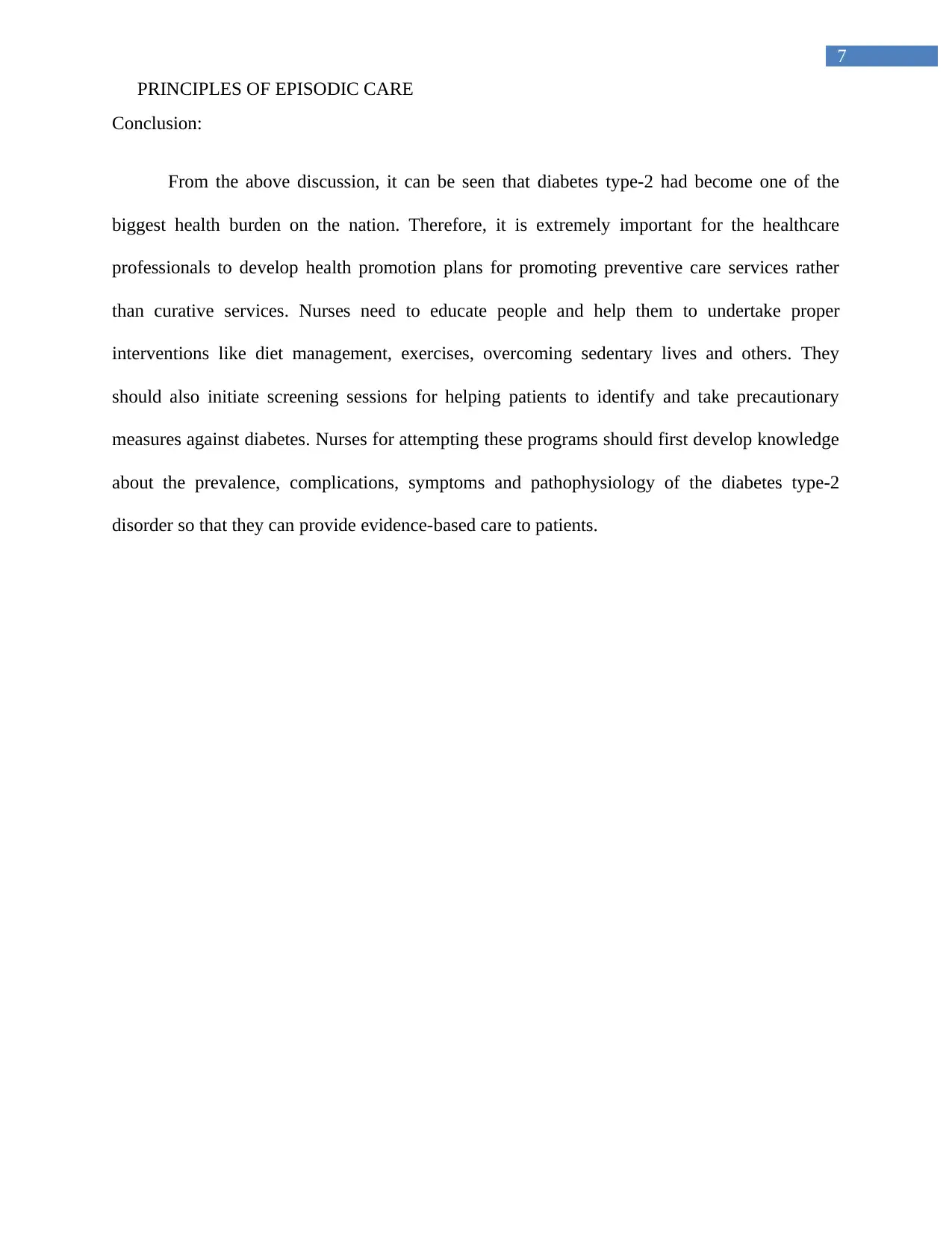
7
PRINCIPLES OF EPISODIC CARE
Conclusion:
From the above discussion, it can be seen that diabetes type-2 had become one of the
biggest health burden on the nation. Therefore, it is extremely important for the healthcare
professionals to develop health promotion plans for promoting preventive care services rather
than curative services. Nurses need to educate people and help them to undertake proper
interventions like diet management, exercises, overcoming sedentary lives and others. They
should also initiate screening sessions for helping patients to identify and take precautionary
measures against diabetes. Nurses for attempting these programs should first develop knowledge
about the prevalence, complications, symptoms and pathophysiology of the diabetes type-2
disorder so that they can provide evidence-based care to patients.
PRINCIPLES OF EPISODIC CARE
Conclusion:
From the above discussion, it can be seen that diabetes type-2 had become one of the
biggest health burden on the nation. Therefore, it is extremely important for the healthcare
professionals to develop health promotion plans for promoting preventive care services rather
than curative services. Nurses need to educate people and help them to undertake proper
interventions like diet management, exercises, overcoming sedentary lives and others. They
should also initiate screening sessions for helping patients to identify and take precautionary
measures against diabetes. Nurses for attempting these programs should first develop knowledge
about the prevalence, complications, symptoms and pathophysiology of the diabetes type-2
disorder so that they can provide evidence-based care to patients.
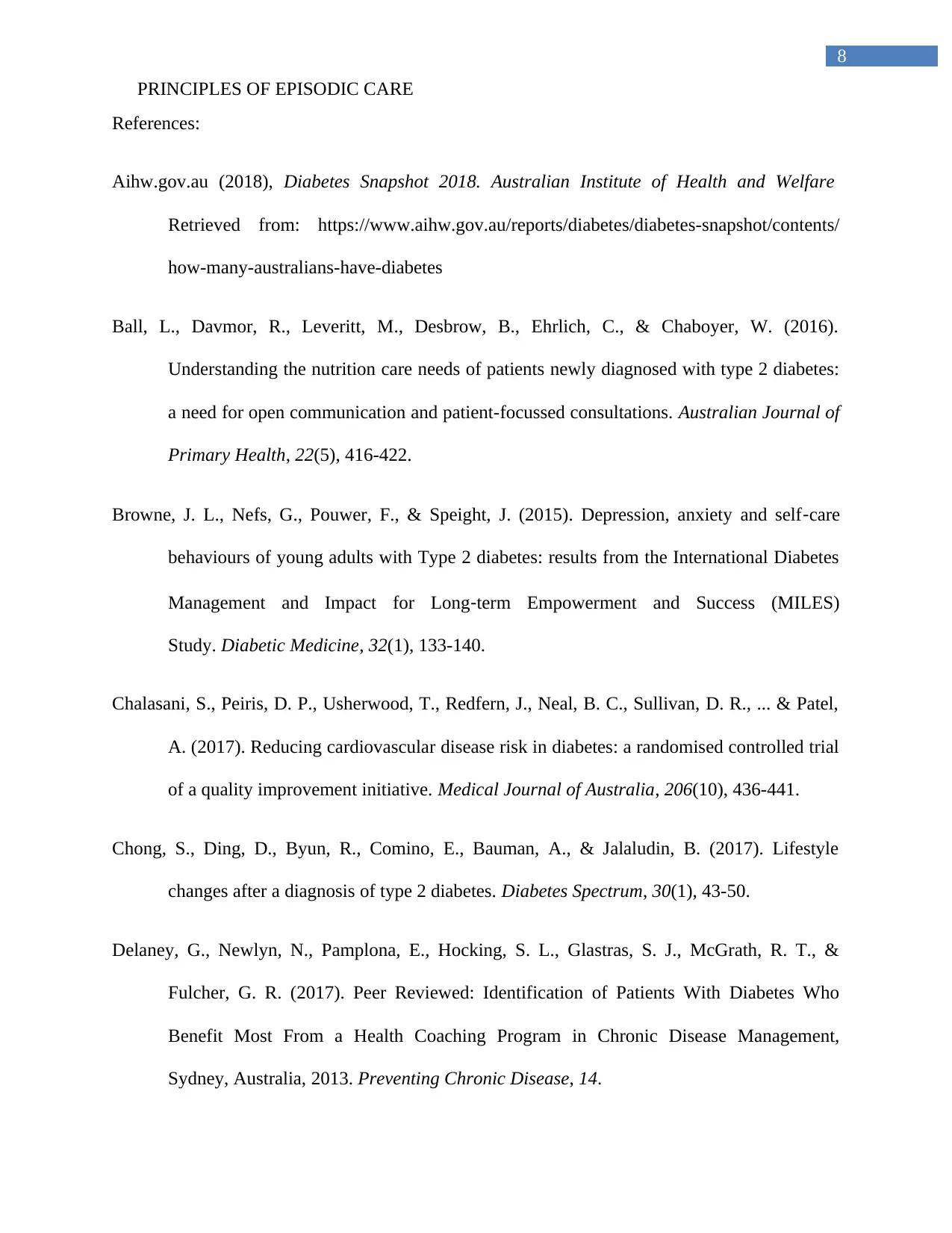
8
PRINCIPLES OF EPISODIC CARE
References:
Aihw.gov.au (2018), Diabetes Snapshot 2018. Australian Institute of Health and Welfare
Retrieved from: https://www.aihw.gov.au/reports/diabetes/diabetes-snapshot/contents/
how-many-australians-have-diabetes
Ball, L., Davmor, R., Leveritt, M., Desbrow, B., Ehrlich, C., & Chaboyer, W. (2016).
Understanding the nutrition care needs of patients newly diagnosed with type 2 diabetes:
a need for open communication and patient-focussed consultations. Australian Journal of
Primary Health, 22(5), 416-422.
Browne, J. L., Nefs, G., Pouwer, F., & Speight, J. (2015). Depression, anxiety and self‐care
behaviours of young adults with Type 2 diabetes: results from the International Diabetes
Management and Impact for Long‐term Empowerment and Success (MILES)
Study. Diabetic Medicine, 32(1), 133-140.
Chalasani, S., Peiris, D. P., Usherwood, T., Redfern, J., Neal, B. C., Sullivan, D. R., ... & Patel,
A. (2017). Reducing cardiovascular disease risk in diabetes: a randomised controlled trial
of a quality improvement initiative. Medical Journal of Australia, 206(10), 436-441.
Chong, S., Ding, D., Byun, R., Comino, E., Bauman, A., & Jalaludin, B. (2017). Lifestyle
changes after a diagnosis of type 2 diabetes. Diabetes Spectrum, 30(1), 43-50.
Delaney, G., Newlyn, N., Pamplona, E., Hocking, S. L., Glastras, S. J., McGrath, R. T., &
Fulcher, G. R. (2017). Peer Reviewed: Identification of Patients With Diabetes Who
Benefit Most From a Health Coaching Program in Chronic Disease Management,
Sydney, Australia, 2013. Preventing Chronic Disease, 14.
PRINCIPLES OF EPISODIC CARE
References:
Aihw.gov.au (2018), Diabetes Snapshot 2018. Australian Institute of Health and Welfare
Retrieved from: https://www.aihw.gov.au/reports/diabetes/diabetes-snapshot/contents/
how-many-australians-have-diabetes
Ball, L., Davmor, R., Leveritt, M., Desbrow, B., Ehrlich, C., & Chaboyer, W. (2016).
Understanding the nutrition care needs of patients newly diagnosed with type 2 diabetes:
a need for open communication and patient-focussed consultations. Australian Journal of
Primary Health, 22(5), 416-422.
Browne, J. L., Nefs, G., Pouwer, F., & Speight, J. (2015). Depression, anxiety and self‐care
behaviours of young adults with Type 2 diabetes: results from the International Diabetes
Management and Impact for Long‐term Empowerment and Success (MILES)
Study. Diabetic Medicine, 32(1), 133-140.
Chalasani, S., Peiris, D. P., Usherwood, T., Redfern, J., Neal, B. C., Sullivan, D. R., ... & Patel,
A. (2017). Reducing cardiovascular disease risk in diabetes: a randomised controlled trial
of a quality improvement initiative. Medical Journal of Australia, 206(10), 436-441.
Chong, S., Ding, D., Byun, R., Comino, E., Bauman, A., & Jalaludin, B. (2017). Lifestyle
changes after a diagnosis of type 2 diabetes. Diabetes Spectrum, 30(1), 43-50.
Delaney, G., Newlyn, N., Pamplona, E., Hocking, S. L., Glastras, S. J., McGrath, R. T., &
Fulcher, G. R. (2017). Peer Reviewed: Identification of Patients With Diabetes Who
Benefit Most From a Health Coaching Program in Chronic Disease Management,
Sydney, Australia, 2013. Preventing Chronic Disease, 14.
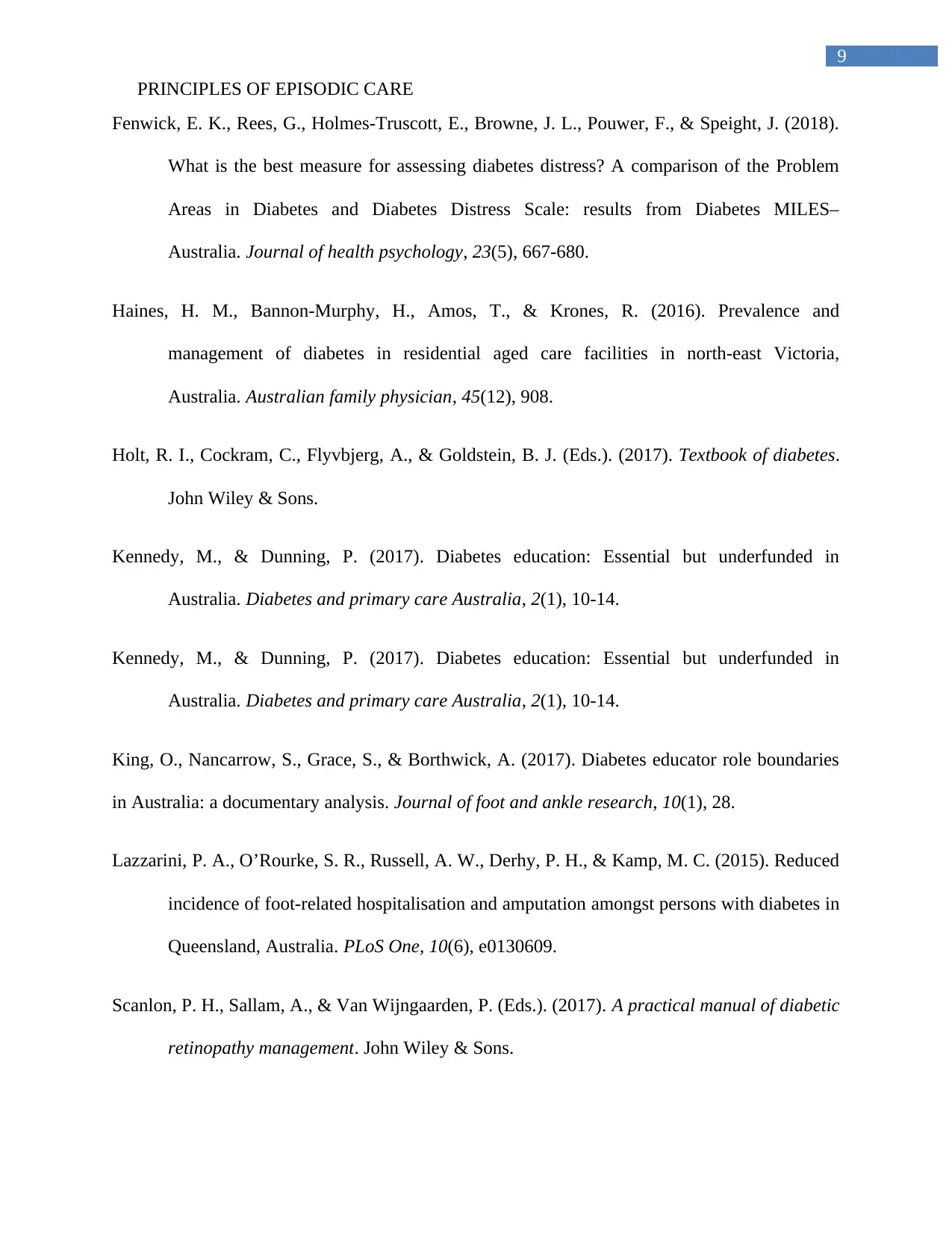
9
PRINCIPLES OF EPISODIC CARE
Fenwick, E. K., Rees, G., Holmes-Truscott, E., Browne, J. L., Pouwer, F., & Speight, J. (2018).
What is the best measure for assessing diabetes distress? A comparison of the Problem
Areas in Diabetes and Diabetes Distress Scale: results from Diabetes MILES–
Australia. Journal of health psychology, 23(5), 667-680.
Haines, H. M., Bannon-Murphy, H., Amos, T., & Krones, R. (2016). Prevalence and
management of diabetes in residential aged care facilities in north-east Victoria,
Australia. Australian family physician, 45(12), 908.
Holt, R. I., Cockram, C., Flyvbjerg, A., & Goldstein, B. J. (Eds.). (2017). Textbook of diabetes.
John Wiley & Sons.
Kennedy, M., & Dunning, P. (2017). Diabetes education: Essential but underfunded in
Australia. Diabetes and primary care Australia, 2(1), 10-14.
Kennedy, M., & Dunning, P. (2017). Diabetes education: Essential but underfunded in
Australia. Diabetes and primary care Australia, 2(1), 10-14.
King, O., Nancarrow, S., Grace, S., & Borthwick, A. (2017). Diabetes educator role boundaries
in Australia: a documentary analysis. Journal of foot and ankle research, 10(1), 28.
Lazzarini, P. A., O’Rourke, S. R., Russell, A. W., Derhy, P. H., & Kamp, M. C. (2015). Reduced
incidence of foot-related hospitalisation and amputation amongst persons with diabetes in
Queensland, Australia. PLoS One, 10(6), e0130609.
Scanlon, P. H., Sallam, A., & Van Wijngaarden, P. (Eds.). (2017). A practical manual of diabetic
retinopathy management. John Wiley & Sons.
PRINCIPLES OF EPISODIC CARE
Fenwick, E. K., Rees, G., Holmes-Truscott, E., Browne, J. L., Pouwer, F., & Speight, J. (2018).
What is the best measure for assessing diabetes distress? A comparison of the Problem
Areas in Diabetes and Diabetes Distress Scale: results from Diabetes MILES–
Australia. Journal of health psychology, 23(5), 667-680.
Haines, H. M., Bannon-Murphy, H., Amos, T., & Krones, R. (2016). Prevalence and
management of diabetes in residential aged care facilities in north-east Victoria,
Australia. Australian family physician, 45(12), 908.
Holt, R. I., Cockram, C., Flyvbjerg, A., & Goldstein, B. J. (Eds.). (2017). Textbook of diabetes.
John Wiley & Sons.
Kennedy, M., & Dunning, P. (2017). Diabetes education: Essential but underfunded in
Australia. Diabetes and primary care Australia, 2(1), 10-14.
Kennedy, M., & Dunning, P. (2017). Diabetes education: Essential but underfunded in
Australia. Diabetes and primary care Australia, 2(1), 10-14.
King, O., Nancarrow, S., Grace, S., & Borthwick, A. (2017). Diabetes educator role boundaries
in Australia: a documentary analysis. Journal of foot and ankle research, 10(1), 28.
Lazzarini, P. A., O’Rourke, S. R., Russell, A. W., Derhy, P. H., & Kamp, M. C. (2015). Reduced
incidence of foot-related hospitalisation and amputation amongst persons with diabetes in
Queensland, Australia. PLoS One, 10(6), e0130609.
Scanlon, P. H., Sallam, A., & Van Wijngaarden, P. (Eds.). (2017). A practical manual of diabetic
retinopathy management. John Wiley & Sons.
Secure Best Marks with AI Grader
Need help grading? Try our AI Grader for instant feedback on your assignments.
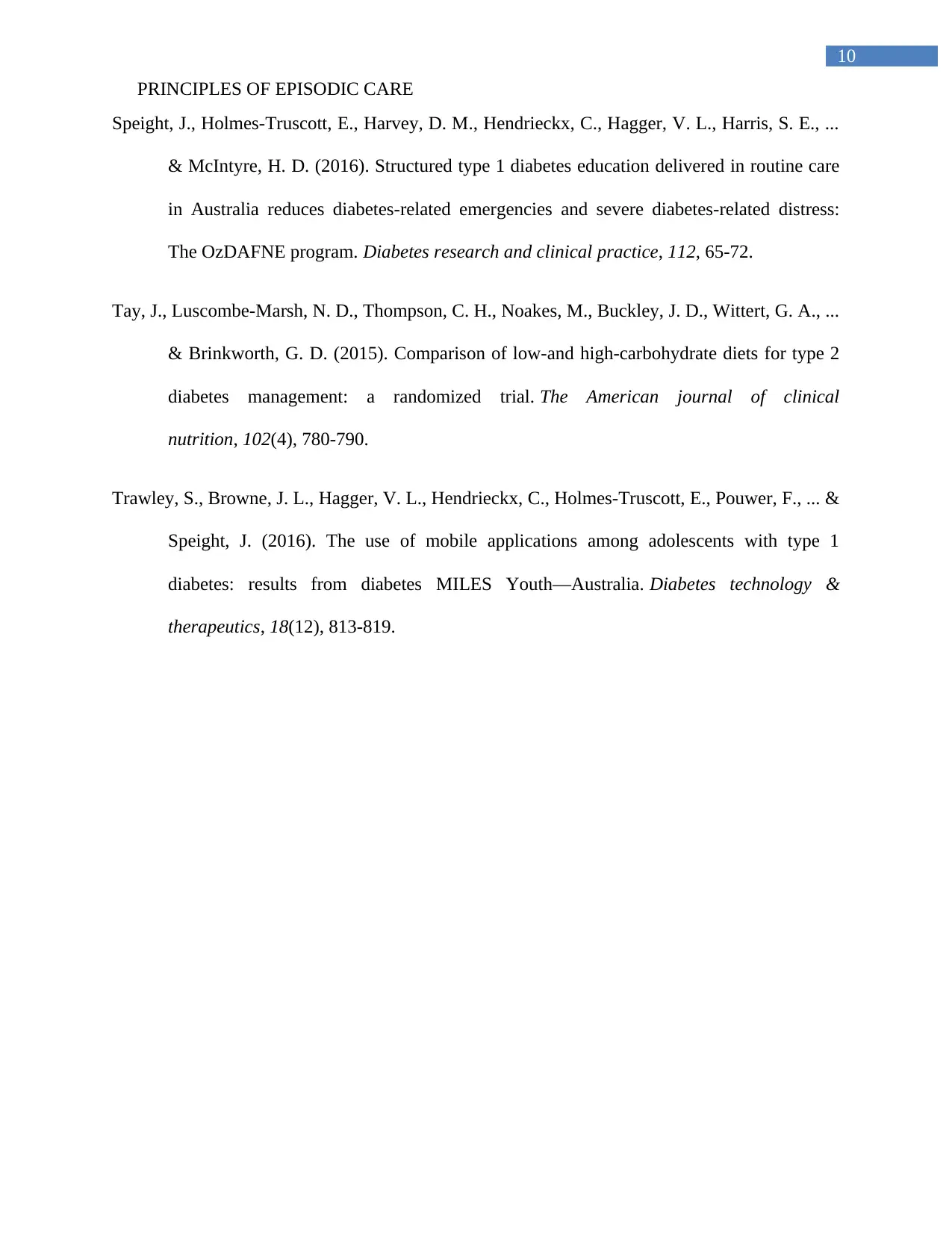
10
PRINCIPLES OF EPISODIC CARE
Speight, J., Holmes-Truscott, E., Harvey, D. M., Hendrieckx, C., Hagger, V. L., Harris, S. E., ...
& McIntyre, H. D. (2016). Structured type 1 diabetes education delivered in routine care
in Australia reduces diabetes-related emergencies and severe diabetes-related distress:
The OzDAFNE program. Diabetes research and clinical practice, 112, 65-72.
Tay, J., Luscombe-Marsh, N. D., Thompson, C. H., Noakes, M., Buckley, J. D., Wittert, G. A., ...
& Brinkworth, G. D. (2015). Comparison of low-and high-carbohydrate diets for type 2
diabetes management: a randomized trial. The American journal of clinical
nutrition, 102(4), 780-790.
Trawley, S., Browne, J. L., Hagger, V. L., Hendrieckx, C., Holmes-Truscott, E., Pouwer, F., ... &
Speight, J. (2016). The use of mobile applications among adolescents with type 1
diabetes: results from diabetes MILES Youth—Australia. Diabetes technology &
therapeutics, 18(12), 813-819.
PRINCIPLES OF EPISODIC CARE
Speight, J., Holmes-Truscott, E., Harvey, D. M., Hendrieckx, C., Hagger, V. L., Harris, S. E., ...
& McIntyre, H. D. (2016). Structured type 1 diabetes education delivered in routine care
in Australia reduces diabetes-related emergencies and severe diabetes-related distress:
The OzDAFNE program. Diabetes research and clinical practice, 112, 65-72.
Tay, J., Luscombe-Marsh, N. D., Thompson, C. H., Noakes, M., Buckley, J. D., Wittert, G. A., ...
& Brinkworth, G. D. (2015). Comparison of low-and high-carbohydrate diets for type 2
diabetes management: a randomized trial. The American journal of clinical
nutrition, 102(4), 780-790.
Trawley, S., Browne, J. L., Hagger, V. L., Hendrieckx, C., Holmes-Truscott, E., Pouwer, F., ... &
Speight, J. (2016). The use of mobile applications among adolescents with type 1
diabetes: results from diabetes MILES Youth—Australia. Diabetes technology &
therapeutics, 18(12), 813-819.
1 out of 11
Related Documents
Your All-in-One AI-Powered Toolkit for Academic Success.
+13062052269
info@desklib.com
Available 24*7 on WhatsApp / Email
![[object Object]](/_next/static/media/star-bottom.7253800d.svg)
Unlock your academic potential
© 2024 | Zucol Services PVT LTD | All rights reserved.




